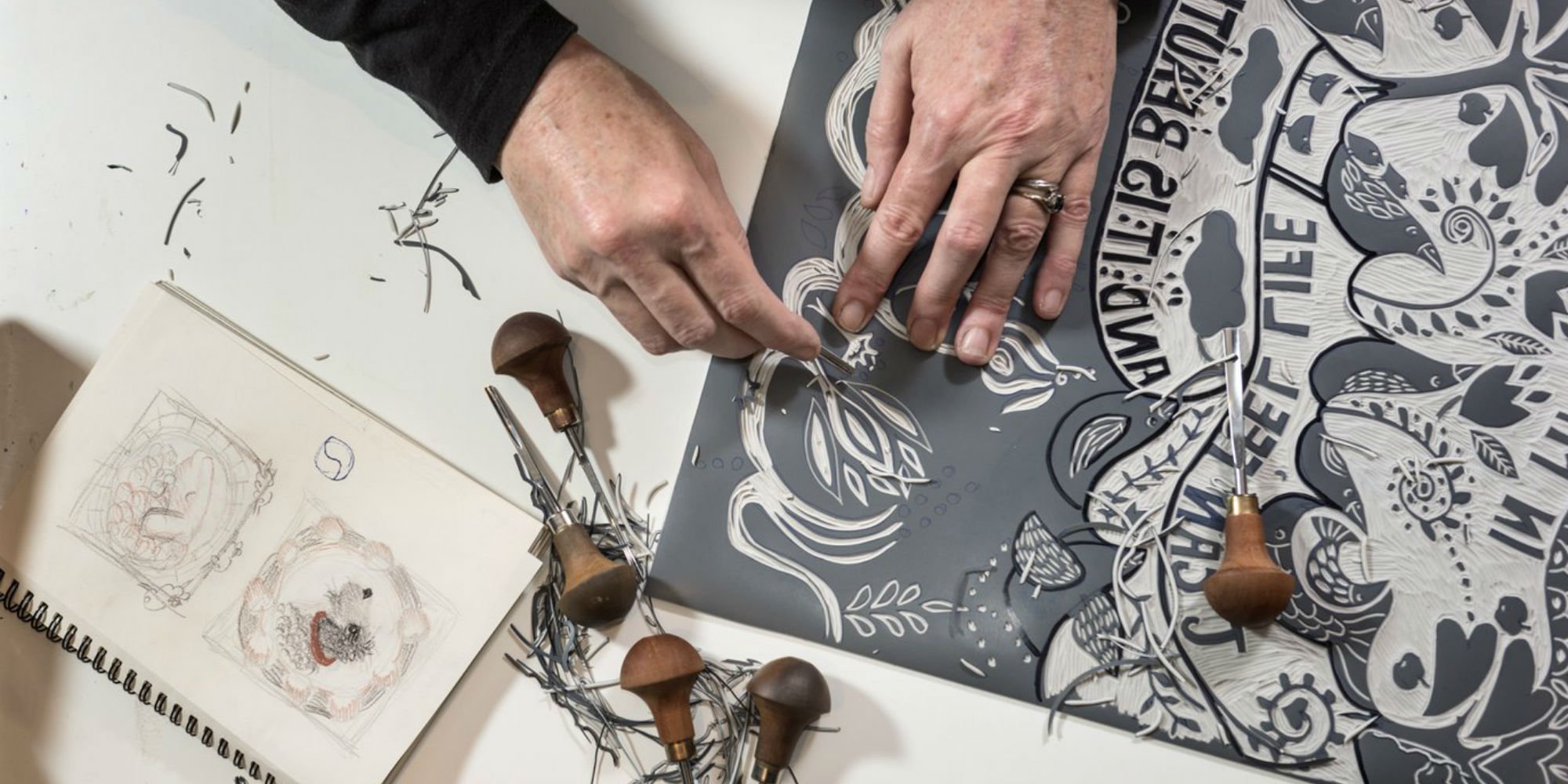The invention of the printing press introduced a whole new form of artmaking for artists. Offering a wide variety of options for creating art, this method may have started its roots in the 15th century, but it’s still very much going strong to this day. From the likes of Andy Warhol, Roy Lichtenstein and Albrecht Dürer, artists have adopted different printmaking techniques to truly define their own distinctive style.
Unlike reproductions, art prints are not “copies”, as each print is considered an original due to variables in the printmaking process. Artists must be incredibly patient during this process, often going back and forth to perfect their piece as the image does not exist until it’s printed.
Perhaps the most common techniques of printmaking are linocuts, screenprints and etchings. We delve deep into the world of printmaking to discover what truly gives art prints their edge.
Linocuts
Linocuts, or lino artworks, use a piece of linoleum to carve an image that is then inked and pressed against paper. You might remember this process from high school since lino is often used as a teaching material for printmaking in art classes, but these Artfinder prints definitely weren’t made by high schoolers (although, age is but a number!)
Lino artworks are also referred to as relief printing, as it’s what remains behind, not what is cut, that makes up the artwork. One benefit of using linoleum is that it’s much easier to cut than wood, allowing the artist to have better control over the carving, which helps introduce more fluid lines to create something truly special.
Pablo Picasso enjoyed creating lino artworks, and produced many pieces with this medium. How did linoleum go from being used as an affordable material for flooring to being used by the likes of Picasso, you ask?
Artists often found wood or metal expensive and hard to carve. When linoleum was introduced, it offered an easier carving surface, which also produced much quicker results. It was first looked upon as an “amateur” material (because it was cheap and used as learning material), until the likes of Henri Matisseand Picasso started using it. They are often credited with inventing reduction linocuts, where a piece of lino is used multiple times in one print and recut after each colour is applied.
Screenprints
Ah, the screenprint — you can’t write about this medium without mentioning the modern and contemporary artists who championed it. The likes of Andy Warhol, Ed Ruscha, and Roy Lichtenstein favoured this method and catapulted it into popularity during the 20th century pop art movement.
Also known as silkscreen, serigraphy and serigraph printing, screenprinting involves wiping ink through a stencil placed on a screen, which can be made of many mediums. Commonly used screen materials include fabric, glass, silk or canvas.
Screenprinting is seen as a successor to stenciling and dates back 1000 years, all the way to China and the Song Dynasty. It was revolutionised in 1910, when the technique was further developed by Roy Beck, Charles Peter and Edward Owens, who produced photo-reactive stencils and solidified the method that we’re so familiar with today.
Differing from more traditional techniques, screenprinting allowed artists to create flat art prints made of vibrant colours, while experimenting with different hues.
This method of screenprinting gave rise to repetition art, where artists would print the same image multiple times, but the result would differ slightly each time. Favoured by pop artists, this process was a way for them to respond to the effects of mass reproduction on modern culture. Warhol, in particular, preferred this method as each art print was slightly degraded with a new transfer.
Warhol once questioned, “Isn’t life a series of images that change as they repeat themselves?”, which nicely sums up the philosophy behind screenprinting.
Etchings
When you think of art, using acid to create an artwork is probably not the first method your mind floats to. With etching printmaking, however, this is all just part of the process and what makes this method so unique.
First popularised in the 15th century by artists such as Albrecht Dürer, etching printmaking is a progression of engraving. Etching works by coating a metal plate in a layer of acid-resistant varnish or wax, which the artist then scratches through with a sharp tool to create their print. The plate is dipped in acid, which cuts through the lines where the metal is exposed, creating fissures. Lastly, ink is added to the cleaned plate, which is transferred to paper to create the print.
Artists can achieve great line depth by controlling how long the plate is suspended in the acid. Shading, too, can be achieved by applying differing degrees of varnish or wax to certain parts of the plate.
Artists such as Rembrandt van Rijn championed this technique into popularity, and it was in fact his etchings that were responsible for the artist’s international success. Most are surprised to hear that it was his printmaking, not his paintings, that saw Rembrandt first rise to fame as an artist.
Rembrandt’s innovations in etching printmaking left a lasting impression on artists using this method for years to follow. His way of experimenting with ink and paper, and how the ink was applied, revolutionised the art of etching. The artist was able to achieve varying tones and contrasts, with a tonality of shadows that dramatically changed the print.
It is a method that is still widely used today by young artists, such as Marcel Dzama, Dinos and Jake Chapman and David Shrigley.
Printmaking Today
Artists continue to take advantage of the benefits of printmaking until this day. As an affordable and accessible form, artists today have transformed printmaking with new, digital approaches and by printing on alternative materials.
Printmaking has now evolved to encompass graffiti art, such as that of Banksy, to billboards, wallpapers, and more. As the roots of the printing process progress, it’s safe to say, printmaking is still very much here to stay.
Cover image via Mariann Johansen-Ellis


